DECEMBER 2020 – We’re delighted to report that Frederick Law Olmsted’s former home on Staten Island is now on the National Register of Historic Places, thanks to our Special Projects Manager Glen Umberger. It was listed on the State Register of Historic Places this past September. Even with Olmsted’s national fame, and the home’s status as an individual City landmark, it wasn’t easy.
Glen worked with the State Historic Preservation Office for three years, while bolstering his documentation of the site’s importance to the early stages of Olmsted’s career.
The lengthy process paid off. The farmhouse, where Olmsted began his landscape experiments, received the highest level of significance on the National Register.
Glen also succeeded in getting the Voelker Orth Museum in Queens and the Bay Ridge Reformed Church in Brooklyn on the National Register of Historic Places this year.
Listing on the National Register is honorific. But the listing also makes buildings potentially eligible for our programs, federal and state preservation tax credits, and special state grants if they are not already individual local landmarks.
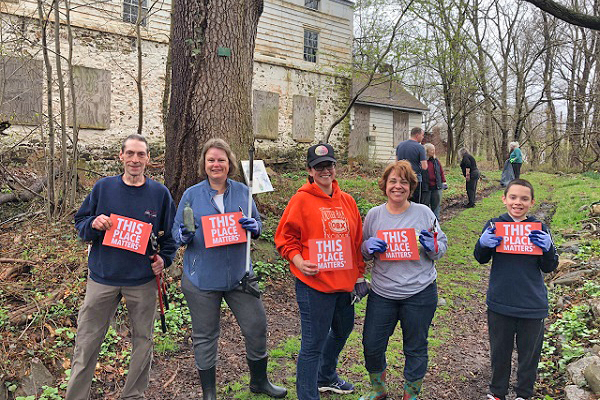
APRIL, 2020
Priority mortar work on the 17th-century foundation of Frederick Law Olmsted’s former home in Eltingville on Staten Island is finally complete. Staff from Fifty Three Restorations worked one at a time in order to complete the work in compliance with social distancing standards. All the priority work the Conservancy identified—and fundraised to pay for—is now finished.
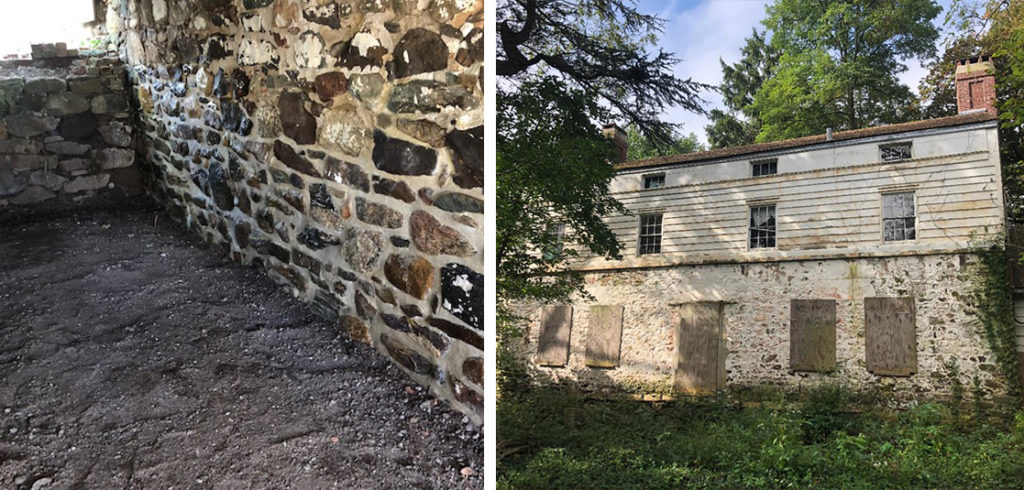
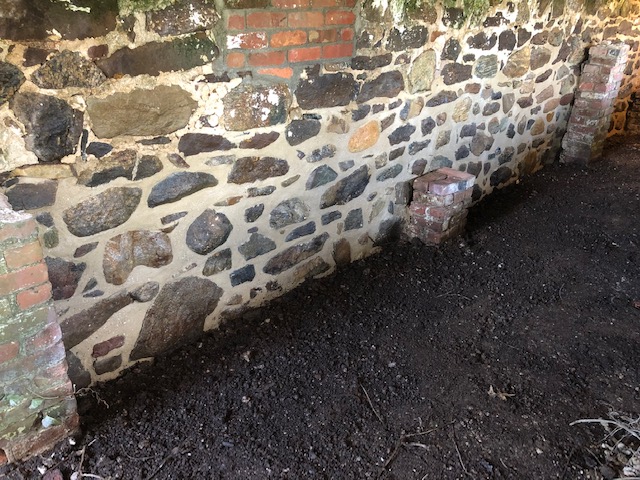
February, 2020 – Conservancy Reaches Goal on Olmsted House Thanks to Staten Island Foundations
We did it! The Staten Island Foundation awarded a $25,000 grant this week that allows us to complete nearly $100,000 in emergency stabilization work at Frederick Law Olmsted’s former home.
Executive Director Betsy Dubovsky said the Foundation “is pleased to support The Conservancy’s efforts to stabilize the Staten Island home of Frederick Law Olmsted and prepare it for adaptive reuse as an education center and park.” She added that the Conservancy’s role “is impressive in galvanizing the support and interest of New Yorkers, as well as regional and national Olmsted enthusiasts.”
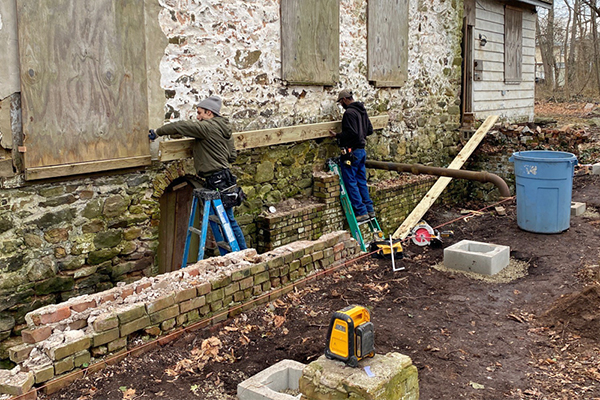
This matches a recent $25,000 grant from the Richmond County Savings Foundation (RCSF). “There are so many historic sites on Staten Island—some of them underappreciated.” RCSF Executive Director Cesar Claro said. “We are happy to help because eventually re-opening this important landmark house will help Staten Island.”
This generous support from these two major Foundations will also help as we continue to press the City to completely restore and open the City-owned property. So will the Friends of Olmsted-Beil, a local group that received an award from the Partnership for Parks this week for their role in publicizing the house.
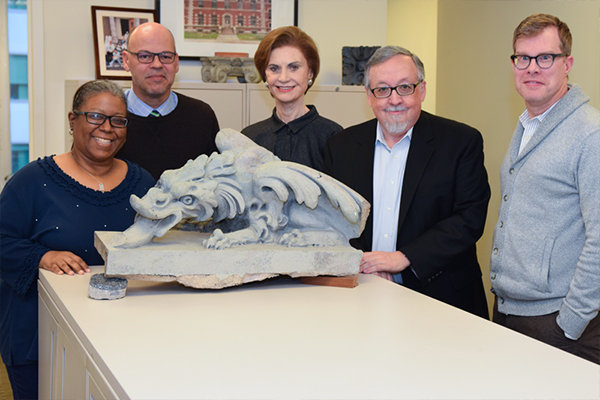
_________________________________________
Foundation Grant Assists Olmsted House Recovery
We are thrilled to announce that The Richmond County Savings Foundation is awarding a $25,000 grant for our stabilization work at Frederick Law Olmsted’s home on Staten Island. This will help us complete $150,000 of priority repairs at the landmark. The work to date has covered the area around the stone foundation to prevent further water penetration, repointed part of the foundation, and laid a waterproof membrane in the basement. The site looks much improved over the past year thanks to the City Parks Department and a local friends group. Earlier grants from The New York Community Trust and the Achelis and Bodman Foundation allowed us to begin initial repairs, along with many individual donors. We are continuing to fundraise.
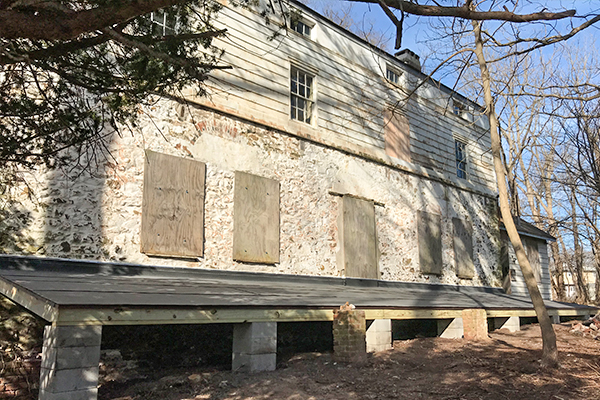
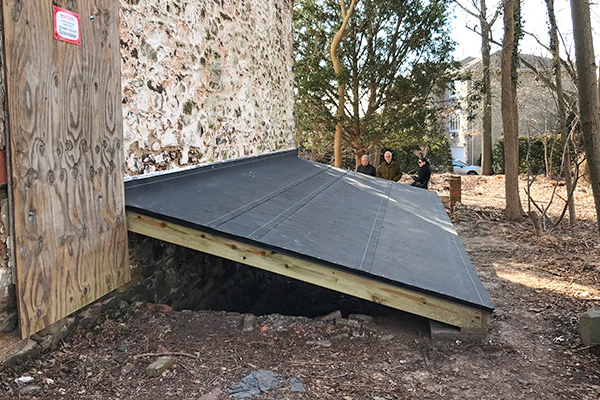
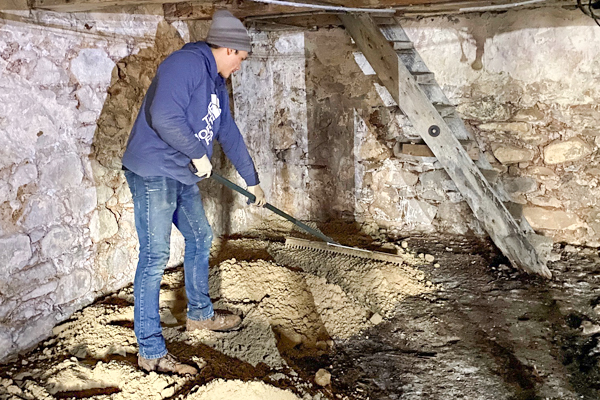
_________________________________________
UPDATE: January, 2020 – Stabilization Begins at Olmsted House
Stabilization work will commence at the Olmsted-Beil House on January 9. After a long process of obtaining City approvals, we finally got the green light to proceed from the Parks Department in late December.

The work will include waterproofing the basement to cut down on rising damp from the floor. It also includes a temporary roof over the open areaway surrounding the house on three sides. This will keep rain from reaching the basement walls and will prevent accidental falls into the open ditch.
Other work includes dismantling unstable brick piers and beams that once supported the porch. All salvaged bricks will be saved and stored on site.
Jan Hird Pokorny Architects prepared the drawings and bidding documents and will assist the Conservancy in supervising the work. We are continuing to fundraise to cover the cost of the work.
Help us honor Frederick Law Olmsted’s legacy with a donation.
_________________________________________
Progress at the Landmark Olmsted House
September, 2019
The City Parks Department completed asbestos abatement in the basement of the Frederick Law Olmsted House in mid- August and the urgent repair project is now out to bid. We are arranging walk-throughs with contractors and hope to do emergency work at the house this fall. Olmsted lived in the house in the 1850s and first experimented with landscape design there. Trees he planted are still on the property.
UPDATE: July 2019
The basement at the Olmsted House on Staten Island was cleared of asbestos and mold this month. Now the Conservancy can send out bids on urgent work to protect the house from more water penetration. This will include putting special lining down in the basement to prevent rising damp from the earthen floor and installing plywood shed covers around the house over the basement openings. Workers will also need to shore up beams in the basement that support the first floor. Our thanks to the Historic House Trust for overseeing the remediation. Our work would have been impossible in a contaminated cellar.
Our goal is to stabilize and protect Frederick Law Olmsted’s former farm in Eltingville so the City can fulfill its 2006 promise to open the landmark building and property to the public. Olmsted, who helped create Central and Prospect Parks, began experimenting with landscape design while living on Staten Island from 1847 to 1855. The earliest part of the landmark home dates to the late 1600s. The grounds are an official City park. Both were seriously neglected until the Conservancy began a campaign to raise help for the house last winter.
_________________________________________
UPDATE: January 2019
New York Community Trust Boosts Olmsted House Funding
The New York Community Trust has given a $40,000 grant to cover architectural and engineering expenses connected with stabilizing Frederick Law Olmsted’s home on Staten Island. Thanks to them, we have now raised $92,400 towards our $150,000 goal.
We have enough in hand now to do priority work on the house this summer. There needs to be asbestos abatement first.The Parks Department will perform that as soon as contracts for the work get final City approval.
Work this summer will include waterproofing the floor of the basement to bring down humidity in the house, re-pointing stone masonry in places where the mortar has eroded, building a temporary shed roof over the exposed ditch surrounding the house where the porch had been, removing and salvaging brick piers that had supported the porch, and removing of debris in areaways adjacent to the house.
Olmsted began experimenting with landscape design while living at the house, which is an early City landmark. When the Parks Department purchased the house and grounds in 2006, they said they intended to create a nature study center at the site.
_________________________________________
Rescue Meeting at Frederick Law Olmsted’s Historic Home
January 2019
Our efforts to save Frederick Law Olmsted’s home on Staten Island took another step forward with a kickoff meeting on January 9th to start the rescue. We were joined by our architectural team from Jan Hird Pokorny Associates as well as representatives from the Department of Parks and Recreation, The Historic House Trust and the Landmarks Preservation Commission.
The architects took measurements of the house, inside and out, to prepare base drawings. They also re-inspected the interior to update the initial 2018 conditions report. Shoring up the first floor of the house is a top priority. Once the drawings of the cellar are prepared, a structural engineer will visit the site to determine how exactly to do that.
We also anticipate building a temporary roof over the open ditches surrounding the house where the porches once stood to prevent water penetration into the basement. The Conservancy is funding the work thanks to a successful Kickstarter campaign and generous grant from the Achelis and Bodman Foundation. We are continuing to fundraise.
_________________________________________
Eltingville, Staten Island – December 2018
Olmsted Home Receives a $25,000 Grant
Frederick Law Olmsted’s Staten Island home is another step closer to being stabilized thanks to a $25,000 grant from The Achelis and Bodman Foundation we received on December 19. Added to the $27,350 generated by a successful Kickstarter campaign and direct donations, the grant ensures that the most crucial work on this important landmark can be done this spring.
We’re thrilled The Achelis and Bodman Foundation gave our efforts a boost and grateful to the more than 200 individual contributors to our campaign to date. The Conservancy needs to raise another $97,650 to cover all the stabilization needs. All the funds raised will be used for work on the house. The ultimate goal is to have the Parks Department, which owns the house, complete the restoration and adapt the building and grounds for public use.
While living in this house in the 1840s, Olmsted began experimenting with plantings that informed his later plans for Central and Prospect Parks, as well as parks around the country. His home could, and should be a destination for New Yorkers and visitors alike.
_________________________________________
November, 2018
KICKSTARTER CAMPAIGN!
You helped save Olmsted! Heartfelt thanks to the 211 generous backers who pledged $22,000 to our Kickstarter Campaign to reclaim Frederick Law Olmsted’s home on Staten Island. We would also like to thank our colleague organizations who shared our campaign with their followers including Friends of Olmsted-Beil House, Frederick Law Olmsted Society, The Cultural Landscape Foundation, Untapped Cities, and The Historic House Trust of New York City. Our fundraising efforts to stabilize the house are off to a great start.
We did it….TOGETHER!
This Kickstarter Campaign was the initial step of a $150,000 campaign to stabilize the building so that ultimately the City’s Parks Department can complete the restoration and adapt the building for use as an educational center.
______________________________________________________
WHY IS THIS IMPORTANT
Tucked away on the South Shore of Staten Island is a forgotten and abandoned landmark in desperate need of attention. The Frederick Law Olmsted Farmhouse, presently known as the Olmsted-Beil House served as the early Staten Island residence of the eminent landscape architect, Frederick Law Olmsted from 1848 until 1854. Olmsted’s work here greatly influenced his later landscape designs of Central and Prospect Parks in New York City and other parks across the country.
Alerted to its severely neglected condition last summer, the New York Landmarks Conservancy led a national campaign to sound the alarm about this endangered landmark and paid for an updated Conditions Assessment Report, which showed that it would cost $153,400 to stabilize the house.
WHAT WILL YOUR CONTRIBUTION SUPPORT
For the first phase of this project, the Conservancy is seeking to raise $16,000 to immediately fund the temporary stabilization of the first floor, repair broken windows, and repaint the exterior wood siding of the house. Completing this stabilization is the necessary first step so that the house and grounds can be turned into an environmental and educational center on landscape architecture today.
Reclaiming the Olmsted House is not part of the Conservancy’s annual budget but we recognize the importance of restoring this landmark site so that it can eventually offer programs to New Yorkers and visitors alike. We are working with the New York City Department of Parks and Recreation and a newly activated Friends group on Staten Island, but we need you to join us to save this national treasure.
NOTABLE SUPPORTERS
Notable Parks advocates have joined the Conservancy in forming the Reclaim Olmsted House Committee and endorse our campaign including:
Elizabeth Barlow Rogers, President, Foundation for Landscape Studies; Founder, Central Park Conservancy
Charles Birnbaum, President, Cultural Landmarks Foundation
Sue Donoghue, President and Administrator, Prospect Park
Gordon J. Davis, former New York City Parks Commissioner
Lynden B. Miller, public garden designer
Adrian Benepe, former New York City Parks Commissioner
Tupper Thomas, Founding President, Prospect Park Alliance
Kenneth Jackson, historian
Ric Burns, documentary film maker
Bernadette Castro, former New York State Parks Commissioner
Kent Barwick, historic preservationist
Janice Monger, President & CEO, Staten Island Museum
Richard Moylan, President, Green-Wood Cemetery
Michael van Valkenburg, landscape architect
NYC Historic House Trust
Ethan Carr, Professor, Landscape Architecture; editor, 8th volume Papers of Frederick Law Olmsted
Victoria Cerullo, Bloomberg LP
WHY KICKSTARTER
This Kickstarter campaign is the catalyst to stabilize the landmark so that ultimately NYC Parks and a local community group can complete the restoration and adapt the building for use as an education center.
_________________________________________
August, 2018
Conservancy Launches a $150,000 Campaign to Stabilize Historic Olmsted Farmhouse in Staten Island
We are now working with the Parks Department to save this nationally important site. And are endeavoring to raise $150,000 for immediate priority repairs. The Olmsted Farmhouse dates in part to the late 1600’s and is an early city landmark. Park officials have asked the Conservancy to raise the private funds so that priority repairs can be undertaken in a timely fashion. We are basing our scope of work and budget on a January 2018 Conditions Assessment Report we commissioned from Jan Hird Pokorny Associates.
The house and site are rare and valuable resources for New York City. The Conservancy has formed a group of noted Parks and Civic leaders to demonstrate the importance of the site and the need for urgent repairs. They include: Elizabeth Barlow Rogers, Lynden B Miller, Gordon J Davis, Ric Burns, Kent Barwick, Bernadette Castro, Kenneth T Jackson, Tupper Thomas, Richard J Moylan, Charles Birnbaum, and Adrian Benepe.
The proposed work will reverse some the ongoing deterioration that the house has suffered in recent years and will help stabilize and preserve it until the Parks Department can fund a full restoration of the house and open it and the surrounding public park to the public. So far, the Parks Department has cleaned up the grounds and has begun to sort through and clean out the interior. A Friends Group is also being formed on Staten Island to support restoration of the house and the City Park in which it sits.
_________________________________________
February 12, 2018 – NEW YORK TIMES ARTICLE
The New York Times story clearly illustrates why we are pushing to save the Frederick Law Olmsted house and grounds on Staten Island.
Far From the Great Lawn, Saving a Home Tied to Central Park
by James Barron
Read The New York Times article
Since buying the property in 2006, and declaring it a City Park, the Parks Department has let the landmark home and the grounds deteriorate. A recent report we commissioned outlines what is needed to stabilize the building, whose earliest part dates to the late 1600’s. While we need to work for City funding, the immediate need is clearing the house of materials left by the family who lived there when it was purchased. All that takes is a will to do it. The Parks Department can and should do that right away. The Parks Department has also recently cleared some of the grounds, showing they can take action when they want to.
We hope the spotlight now on the Olmsted home will finally galvanize the City to restore the house and grounds and make them publicly accessible. That’s what the City promised 12 years ago and what the public deserves.
_________________________________________
January, 2018
Conditions Report Results
A conditions report the Conservancy commissioned on the Olmsted House determined that some $460,000 in repairs are needed to secure this important landmark. We have shared the report with Parks Department officials and Councilman Joseph Borelli of Staten Island, but have yet to hear if they will seek City budget funds.
Architect Michael Devonshire of Jan Hird Pokorny Associates examined every major building feature at the Olmsted House and set out detailed cost estimates for making the necessary repairs. This emergency work will insure that the house is properly sealed and stabilized while it awaits its future restoration and adaptive reuse as an education and nature center.
The report urged the Parks Department to clear out all flammable materials from the interior immediately. The house is full of papers and articles left by the family who sold the building to the City in 2006. Other recommendations include installing a security fence, improving the sealing of the windows and doors, constructing temporary shed roofs over the east and south areaways to protect the exposed foundation walls, mortar analysis and the repointing of the foundation walls.
The House, officially known as the Olmsted-Beil House, is city-owned and sits in a small public park in southeast Staten Island. Both are currently off limits to the public. The House is one of the earliest designated City landmarks.
The Conservancy commends State Senator Andrew J. Lanza of Staten Island for his championing of the House. He is close to securing State funds to purchase the adjacent parcel of land, which was part of the original Olmsted farm. This will provide the house with far better street access, space for parking and a visitor’s center.
The house has an important history that stretches back three hundred years. Parts of the first story date to the 1690’s. The stone portion of the house was complete by 1730. The wooden upper stories were added circa 1830. In 1847 the property was purchased by the young Frederick Law Olmsted and it was there, on a former wheat farm, that he first experimented with his ideas about landscape design and the use of exotic plantings. The grounds still feature several trees that were planted by Olmsted.
_________________________________________
November 2017
After Large Public Response, Parks OK’s a Conditions Survey at Olmsted House
A Conservancy-sponsored inspection of the Olmsted House on Staten Island found the landmark building in a neglected state, needing immediate attention. But it is structurally sound and capable of being restored and opened to the public.
Architect Michael Devonshire, along with Conservancy Technical Director Alex Herrera, performed an exterior and interior inspection of the historic stone and frame home of Frederick Law Olmsted on November 20. Devonshire’s report will prioritize what needs to be done and provide cost estimates that will allow the Parks Department to ask for City capital funding for stabilization and future restoration. The house and grounds, though off-limits to the public, have been an official City Park since 2006.
The good news is that there do not appear to be active roof leaks and that no standing water was found in the cellar even though there have been recent strong rainstorms. The bad news is that the house is moldering away along with its contents. It is filled with books, magazines, lumber and other flammable items that pose a threat to the preservation of the house. These items, which belong to the family that sold the house to the city in 2006, need to be removed as soon as possible. Some of the house’s contents, such as a collection of fossils, books, and glass negatives, are of historical interest. For their protection and that of the house, they must be put in storage off site.
The cellar’s dirt floor brings in moisture to the entire house. Floor beams under the parlor and dining rooms show evidence of rot due to the excess moisture. Pressure-treated wooden posts installed about 16 years ago with a Landmarks Conservancy emergency grant, are still in good condition and provide good support to the beams. But the underlying issues of moisture and rot need to be addressed.
There is damage in the kitchen wing and adjacent areas on the second floor from a fire that occurred several years ago. Most of the damage is due to firefighter’s efforts to open up the walls after the fire was extinguished. This was done to check for any hint of fire spread.
The wide plank pine floors and most of the wood trim and doors appear original and in good condition. Plaster walls and ceilings are damaged in areas. Overall, the interiors are in a very neglected state.
A first draft of Devonshire’s report should be ready in December. Officials from the Parks Department were also at the site. The Department had cleared overgrowth away from the building prior to the inspection. But the rest of the grounds, which include plantings by Olmsted, need attention.
The Conservancy will continue to press for this important site to be restored and opened to the public.
_________________________________________
October 2017
Architect Michael Devonshire of Jan Hird Pokorny Associates has been selected to prepare a report on The Olmsted House on Staten Island. Mr. Devonshire will inspect the property both on the exterior and the interior and will prepare a detailed conditions report that will identify areas of deterioration or concern and formulate a list of priority repairs to address these conditions. The report will also include cost estimates for each work item. The Parks Department can then use the report to apply for the capital funds needed to get the work done. As of this writing, the Conservancy and the Parks Department are seeking to schedule the inspection date.
After acquiring the house and grounds in 2006, the Parks Department announced that it intended to use the house and the surrounding land for educational purposes. But the Conservancy found that the landmark house and grounds are severely neglected. After the Conservancy sounded the alarm and the Parks Commissioner was inundated with mail, the Parks Department agreed to let the Conservancy fund an updated survey.
The house has an interesting history that stretches back three hundred years. Parts of the first story date to the 1690’s. The stone half of the house was completed by 1730. The wooden upper stories were added circa 1830. In 1847, the property was purchased by the young Frederick Law Olmsted and it was there, on a former wheat farm, that he first experimented with his ideas about landscape design and the use of exotic plantings. The grounds still feature several trees that were planted by Olmsted.
The Conservancy and the Parks Department want to make sure that the house is properly sealed and maintained while it awaits its future restoration. The Conservancy intends to work with the Department to ensure that this City Park is re-opened to the public.
_________________________________________
You Made a Difference!
Our great thanks to all of you who emailed the City Parks Commissioner expressing your concern for the deteriorated state of the Olmsted House and grounds in Staten Island. You made a difference.
After receiving a volume of emails, the Department has accepted the Conservancy’s offer to pay for a conditions survey of the house. The survey will give the Department specifics, and allow them to request City capital funding for restoration. The grounds, where trees planted by Olmsted still stand, are severely overgrown despite being an official City park: The Olmsted-Beil House Park. This is where Frederick Law Olmsted put finishing touches on his plan for Central Park. The “father of American landscape architecture” worked with Calvert Vaux on Central and Prospect Parks, as well as preliminary plans for Morningside and Riverside Parks. The conditions survey will be a first step in what will likely be a lengthy process of bringing back the house and grounds. We will keep you informed and ask for your help again with securing City capital funding.
_________________________________________
UPDATE: August 30, 2017
Progress is continuing on our efforts to save the landmarked Olmsted House and grounds on Staten Island. We are pleased to report that the Parks Department has selected an architect for an existing conditions report that the Conservancy will fund. Additionally, the office of State Senator Andrew Lanza has informed us that it has secured State Capital Funds to purchase the adjacent house and site, which was part of the original Olmsted farm. This was confirmed by the Parks Department who stated that the purchase is on track. The adjacent property will help provide better access to the site and will help in its interpretation.
Our campaign has received national attention thanks to the National Cultural Landscape Foundation and National Association for Olmsted Parks. The National Cultural Landscape Foundation has sent alerts to 30,000 members nationwide that have resulted in many messages to the Parks Department. The Foundation has now listed the site, known as Tosomock Farms, as a “Landslide” which is the term they use for endangered landscapes. That listing is meant to draw attention to the site and to encourage community based stewardship decisions (The Cultural Landscape Foundation website).
The National Association for Olmsted Parks also supports our efforts, (Read The Letter).
Frederick Law Olmsted is the father of American landscape architecture and was the designer of Central Park, Prospect Park and dozens of other public and private landscapes throughout the country. Tosomock Farm was his early laboratory where he experimented with various landscape designs and where he first planted a variety of exotic trees and plants. The House and Grounds have been a City park since 2006. As we reported earlier, the historic house is currently in need of restoration and the grounds are severely overgrown.
Thanks again to the many of you who responded to our alerts and contacted the Parks Department to help save this significant cultural and architectural landmark. We will keep you posted as the story unfolds.
________________________________________
July 31, 2017
The former Staten Island home of Frederick Law Olmsted, the father of American landscape architecture, is in a severely neglected state despite being an individual City landmark and City park. Visitors intrepid enough to visit the overgrown location are met with an unwelcoming sign: “Historical Site: No Trespassing.” It deserves to be saved.
After buying the house and grounds, the Parks Department announced that it intended to use the house for educational purposes and the surrounding land as a public park. At that time, the Conservancy gave a $20,000 grant and technical oversight to help stabilize the farmhouse. In a letter to Parks Commissioner Mitchell Silver last week, we offered to pay for an updated structures report.
Lynda Ricciardone, Borough Commissioner for Staten Island, responded to the letter. She did not mention our offer of a grant. Instead, she said capital funding is needed and that the Parks Department is seeking to purchase an adjacent property to improve access. She also noted that a “friends group” would be helpful. The Parks Department enumerated these same steps in 2006. Aside from stabilizing the house after a fire, the Department has not moved forward. Nothing has happened except for the continuing deterioration of the house and grounds.
The Conservancy is sounding the alarm on this endangered landmark. Click here to contact the Parks Department to voice your support for saving this important piece of American landscape architectural history.
Olmsted-Beil House Park in Eltingville is part of “Tomosock Farm,” where Olmsted put the finishing touches on the plan that won the competition for the design of Central Park. Olmsted designed Central and Prospect Parks with Calvert Vaux, as well as preliminary plans for Morningside and Riverside Parks.
Olmsted’s father purchased the original 125 acres of farmland for his son in December 1847. Olmsted cultivated fruit trees and planted other magnificent species of trees, many of which remain on the property today. The first story of the farm house dates to the 1690s, with later additions completed in the 1730s. The upper wood frame stories were added by 1830. On a recent visit, Conservancy staff noted that the building is sealed but its porch has fallen off.
After Olmsted sold the property in 1866, the house had several owners, including the naturalist Carlton Beil, who purchased the property in 1961. The house survives thanks in large part to the Beil family who transferred ownership of the house to the New York City Department of Parks and Recreation in 2006.
